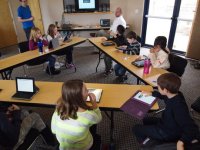Introducing Mobile Technology Into Your Classroom: Structures and Routines
It can be intimidating to try something new in your classroom. This is especially true with technology. I believe that technology should make the work of teachers easier while creating an environment that excites and engages students. Even though I'm coming from an iPad classroom, these structures and routines are great for introducing all one-to-one devices.
Have a System (and Expectations!)
No matter what device you use, have a system. All of the iPads in my classroom's cart are labeled with a student name and number. Each slot is numbered, too. I expect each device to be placed in numerical order (odd on one side, even on the other) when my students return them. That way, I can quickly see which device is missing. When I taught a few groups of students with my one iPad cart, I kept class lists with each student's number taped to the top of my cart. When calling students to retrieve or put away their iPad, I often call out "all even" or "all odd," or give a range like "1-10." Students need to know that they are accountable for the well being of their device and that its wear and tear can be traced back to them. And something as simple as establishing a flow of traffic in your room for returning and picking up devices can lessen transition time between activities.
Be Clear and Consistent
Don't take it for granted that your students will know what you're thinking. If you fail to list expectations early, students will explore their device in ways you might not anticipate. I ask my fifth graders to stay away from their iPad's settings. This means that the background image won't be changed, font size and type will stay the same, and no devices will be given passwords. Be explicit about your expectations, and don't make assumptions. You might ask students to refrain from changing the look of a screen so that apps and icons stay in the same place. Just like many routines and structures in my classroom, I'll post a list of expectations for students to use as a reference.
Start Small
Choose two or three apps or programs to tackle at first. To avoid feeling overwhelmed by the abundance of choices, create a short list of "everyday applications." Start adding one or two new apps a week to build your base. Determine which students are your experts (or could easily become experts), and have them be the first to try out an app. Show them the ins and outs of an app during a free period. That way, when you introduce this new app to the class, you'll have three or four students who can help troubleshoot or answer quick questions for members of their group.
Substitute Regular Activities
Instead of trying something completely out of the ordinary from the get-go, replace one of your usual activities with technology. For example, have students type on virtual sticky notes instead of writing on paper ones. Students can send you an email in place of filling out an exit slip. Practice math facts using virtual flashcards. Use a camera to record a science presentation. Explore an atlas app instead of flipping thorough a textbook. Simple activities will build your confidence (and your students' confidence!) with using one-to-one technology in your classroom.
Are you in a one-to-one classroom? What are some challenges you've faced? What advice do you have to offer? Please share in the comments section below.
